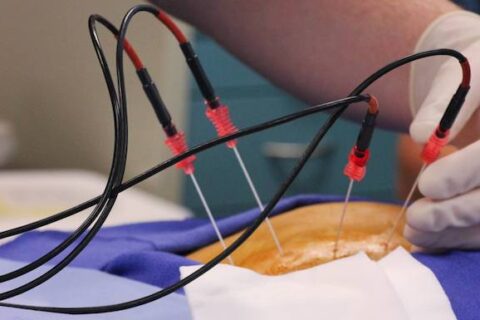Thoracic facet radiofrequency neurotomy is a surgical pain management technique that eliminates the nerves’ ability to transmit pain signals to the brain. This treatment uses the common radiofrequency neurotomy technique (also known as radiofrequency ablation) to target suprascapular nerve block in the thoracic facet joints of the spine. These are located in the middle and upper back, and are commonly the source of back pain. By carefully heating these nerves, pain signals can no longer be transmitted to the brain, meaning that patients can enjoy lasting pain relief.
THORACIC FACET RADIOFREQUENCY NEUROTOMY

THORACIC FACET RADIOFREQUENCY NEUROTOMY
THORACIC FACET RADIOFREQUENCY NEUROTOMY
-
How is Thoracic Facet Radiofrequency Neurotomy Performed?
The thoracic facet radiofrequency neurotomy procedure, although surgical, is fairly simple. First, the treatment area will be numbed to ensure that you remain safe and comfortable throughout the duration of the treatment. Then, a small needle will be inserted into the nerves where pain signals are originating. Once in place, we will apply controlled radiofrequency energy to the nerves using this needle. This process heats and damages the nerves, preventing them from sending pain signals through the body. The thoracic facet radiofrequency neurotomy treatment takes about an hour to perform.
-
What is Recovery Like After Thoracic Facet Radiofrequency Neurotomy?
After thoracic facet radiofrequency neurotomy, patients are encouraged to take at least a day off of normal activities. Exercise, heavy lifting, and other strenuous activities should be avoided for at least a few days. You may notice some swelling, soreness or bruising in the treatment area, but these symptoms should fade shortly after treatment.
-
What Kind of Results Can I Achieve from Thoracic Facet Radiofrequency Neurotomy?
After thoracic facet radiofrequency neurotomy, the nerves are no longer able to transmit pain signals to the brain. This means you should notice an improvement in your pain levels as soon as immediately after your procedure. The body heals itself over time, meaning that your nerves will regenerate and some pain may return.
However, most patients enjoy the results from their thoracic facet radiofrequency neurotomy treatment for a year or longer. The procedure can be repeated as needed.







